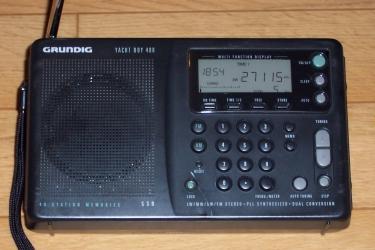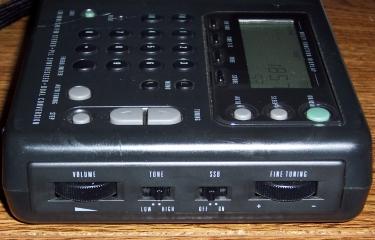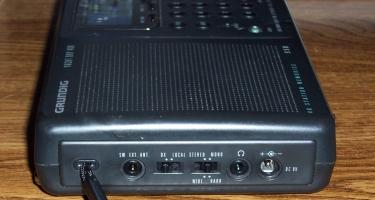    
Tech833
Moderator
Username: Tech833
Post Number: 956
Registered: 8-2002
| | Posted on Thursday, January 20, 2005 - 12:07 am: | 


|
The Grundig YB 400 'Yacht Boy' and YB 400 PE
Review By
Tech833
Introduced nearly 10 years ago, the Grundig YB 400 hit the shortwave receiver market filling a niche that did not yet truly exist. For a long time, you had full coverage large receivers and you had small feature-poor portables. The YB 400 was the first high quality, small portable that offered full frequency coverage as well as high quality performance.
The YB 400 covers 144-353 kHz., 520 kHz. to 30.000 MHz. (continuously), and the FM broadcast band. The potent portable YB 400 is truly a wide band receiver. Not 'toyish' in any way! When you operate the YB 400, it feels 'real'. As many SW enthusiasts know, the words 'portable' and 'shortwave' are seldom in the same sentence without getting a mental image of a toy radio that is too deaf to hear anything but the biggest border blasters. With the YB 400 performance, thick, tough feeling case and the BIG sound, the YB 400 will change your mind.
Performance on LW is really unexpectedly good, especially considering this is a portable! This radio is MUCH more sensitive on LW than a general coverage ham radio. With the built in ferrite bar antenna, LW performance is not only adequate, but downright a pleasure to use.
Listening on the AM broadcast band is also a pleasure thanks to the YB 400's very potent sounding built in speaker. This has long been a Grundig trademark. How does Grundig achieve such full sound from such small radios? The YB 400 sounds very full and lifelike, and it also has plenty of volume! You could use the built-in 'kickstand' and the YB 400 would be right at home on an office desk filling your area with music or capably delivering your favorite AM talk show.
SW tuning is normally done with a tuning knob on about every radio I have ever owned. The YB 400 does away with a tuning knob and instead gives you the option of directly choosing a frequency with the keypad or using 'UP' and 'DOWN' buttons. I have to say that I honestly miss the tuning knob for a couple reasons. First of all, when using the buttons on the YB 400 to tune the band, each time the frequency changes, the radio 'pops'. If you hold the button down, the frequencies scroll quickly, and the radio pops quickly too. During the frequency jump and audio pop, the received audio is muted. This makes band surfing a little difficult. My other reason has everything to do with band surfing. Part of the fun with shortwave surfing is having a radio than can cover a lot of ground with a quick turn of the dial. The YB 400 has 1 speed, and it is not very fast. When tuning a wide portion of the spectrum, you have to have patience. Grundig has solved this problem with the YB 300, but the higher end YB 400 still does this.
The YB 400's strong point on SW is the BFO (Beat Frequency Oscillator) which allows you to tune in SSB (sideband) broadcasts. Very few portables offer SSB capability. The YB 400's BFO does allow SSB and CW reception, but it is not a true LSB or USB receiver. If someone is using USB while someone is using LSB on the same frequency, you hear them both 'competing' instead of being able to listen to just one sideband. This is almost never a problem except during contest weekends on the ham bands or on the CB band during high sunspot activity. When listening to military or SW SSB broadcasts, the YB 400's BFO is completely adequate.
Something unexpected but very welcome was the discovery that the YB 400 will give you stereo on the FM broadcast band if you use earphones! You could theoretically use the YB 400 for 'everyday' headphone listening as it is only about twice the size of an AM/FM/cassette Walkman. However, with the YB 400, the FM sensitivity is extremely good and will blow the doors off any Walkman.

Let's take the tour! On the front panel, you see the large backlit screen showing frequency, signal strength status and two digital clocks. Yes, TWO clocks! I set up my YB 400 clock 1 to be local time and clock 2 to be UTC. The YB 400's clocks will also function just like an alarm clock. Hey, you could set the YB 400 to automatically switch on for the CEF nets! The YB 400 conveniently has a 'sleep timer', which will turn the radio off in 60 minutes after pressing the 'sleep' button. If you press the 'sleep' button again and again, each press will lower the 'on' time by 10 minutes. There is also a 'snooze' button (next to the light button) on top of the radio for you procrastinators.
The frequency keypad is below the display and also aids with clock setting and some programming. The large 'Up' and 'Down' frequency buttons are to the right of the keypad. Just below the tuning buttons is a 'step' button that allows you to change the amount of frequency jumped each time an 'UP' or 'DOWN' button is used. For instance, when tuning European AM broadcast band stations, they are spaced every 9 kc. However, while tuning US AM stations, you will be better off choosing the 1 or 5 kc. steps.

On the business end of the YB 400 you find the volume control, the tone 'HI' and 'LOW' switch, the BFO ON-OFF switch, and the fine tuning (BFO tuning). I wish the YB 400 had a true tone control, rotary style, instead of the 'hi-low' switch. When the tone is set to 'hi', the low end is rolled off sharply and everything sounds thin and 'toyish'. Switching to 'low' gives the YB 400 that full, rich Grundig sound, but may roll the high end off a little too quick for hi-fi AM listening. It is 'about right' for SW listening.

The other end panel of the YB 400 has the external power jack (9 volts DC), and the 1/8 inch stereo headphone jack. Next to that are two switches. The first has a dual purpose of choosing either 'WIDE' or 'NARROW' AM bandwidth and also FM stereo or mono reception. When in stereo FM position, it is then also in the AM wide mode. You could look at it this way- Hi-fi on one side, low-fi on the other. The second switch selects the sensitivity level, either 'local' or 'DX'. This affects every band, including FM. Last is the 1/8" jack for external SW antenna input.
You can store up to 40 frequencies in the YB 400. You can then scroll through just your saved frequencies by using the 'memo UP' or 'memo DOWN' buttons. If you hold down one of the memo buttons, the YB 400 scans through them just like a scanner radio. The memory channel is shown on the display right below the frequency. Hey, how convenient! You can store the 40 CB channels as memory channels 1 through 40. Neat!
O.K., enough of that- lets use it! Since I like backpacking and camping out on mountains where power lines and cars never go, this was a great opportunity to try the YB 400 in the 'real world'. Using the Grundig reel type SW wire antenna, I found the YB 400 to be really sensitive and every bit a serious shortwave radio. Tuning is difficult for band surfers, but I came armed with a list of specific targets. Trying for utility stations and clandestine stations would be nearly impossible or frustrating otherwise. This trip, I decided to try some pirates (the shortwave band's version of freebanders). I was quickly rewarded with WBMR booming in on 6925 kHz. I listened to their program until signoff and then listened to some pirates having a rare 'round table' on 6925 LSB. Tuning the BFO was touchy, especially when trying to tune multiple stations conversing and slightly off frequency from each other. The BFO control is not a 'hands off' setting.
The volume was camp piercing and as the moon rose over the rocks, I had to switch to headphones. In the wee hours of the morning, I topped off the session with some LW beacons. Hearing stations from all over Northern California, including DGPS beacons, with such ease was a real pleasure. The YB 400 smooth sound was not fatiguing, even when trying to remember the morse code to ID the stations I copied (it was going on 22 hours without sleep). I discovered that turning the YB 400 could null and peak LW stations just like on the AM broadcast band. That is typical of radios having a ferrite rod antenna.
The YB 400 runs off of 6 'AA' batteries and they held up ALL night. I am not exactly sure how long the YB 400 will actually run on one set of batteries, but it seems like nearly for ever. I have had the same set in my YB 400 for about 6 months of casual listening and only killed them when I left the radio on when I put it away once. It is now on only its second set of batteries since I have owned it. Not bad for a dedicated SW junkie. Running the YB 400 on a 9 volt 'wall-wart' transformer was not disappointing either.
In short, the YB 400 sensitivity and all out performance will rival any of the high-end radios I have used, all except the over $1000 range. I would certainly consider the YB 400 for portable or occasional base use. As a main radio, I would be hesitant if you can afford a full-blown shortwave machine. However, for the budget conscience or those who want to try SW before spending a ton of money but want a hot performing radio, the Grundig YB 400 is perfect. It is a lot more radio than the price tag reflects. The YB 400 is on my list of favorites and it will probably find itself on yours too.
Tech 833
|



